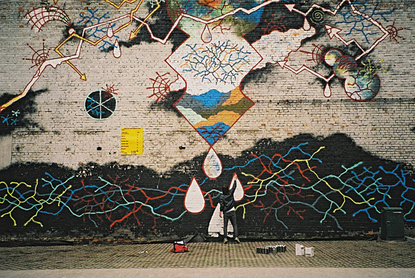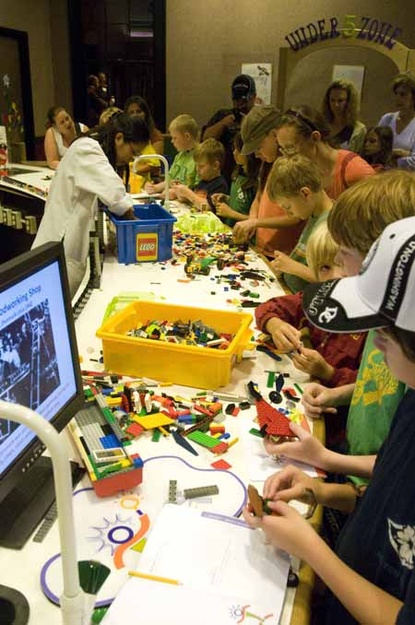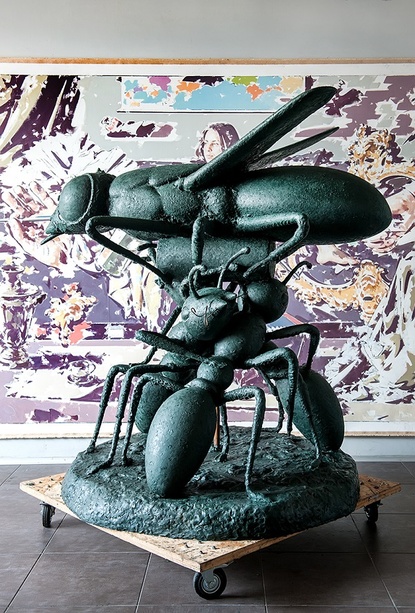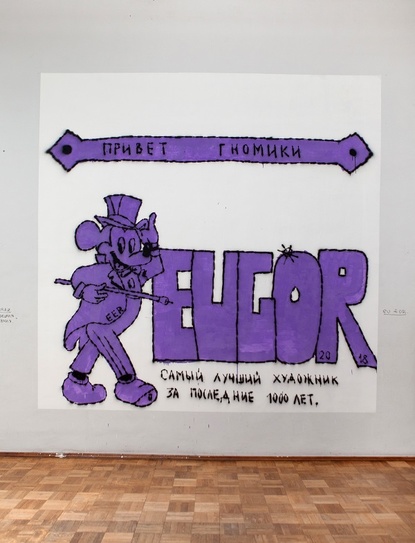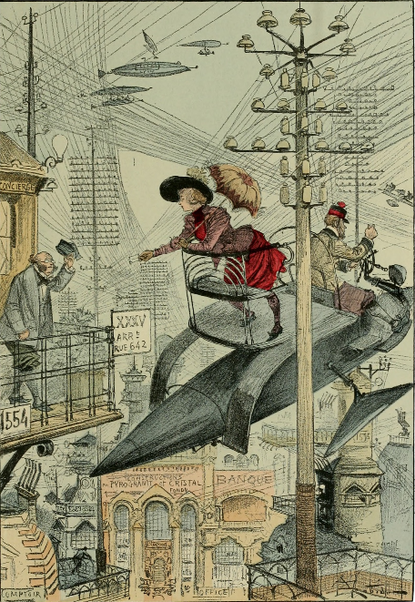ART NOW: Stepan Ryabchenko. On art of the new era
At the initiative of art dealer Igor Abramovych, ART UKRAINE continues the cycle of conversations with famous Ukrainian artists ART NOW. In series of interviews, artists tell details about new projects, discuss the socio-political and cultural contexts of today, also the problems of the national art system and the prospects for its development.
The focus of the artist Stepan Ryabchenko, an architect on education, is the interaction of new technologies and classical fine traditions, the boundary between the real and virtual world, the study of the renewed nature of contemporary art. In the installations, sculptures and pictures, the author creates a large-scale story about the virtual world. About the invented mythology, partial transition to animation, the concept of designing the medium in the format of image Ryabchenko told ART UKRAINE editor-in-chief Roksana Rublevskaya.

Stepan Ryabchenko
Photo by Alexander Kozachenko
– Do you think that the use of digital computer technologies allowed the fine arts to abandon the understanding of an art work as a material object and from the recognition of uniqueness as an attribute of originality?
– I would say that computer technologies, first of all, expanded the horizon in all spheres, including art, both in the field of new ideas and images, and in instrumentation field. And the opportunity to materialize virtual images with the help of new technologies was, and still is, this part stays is also very interesting for me. On the other hand, in parallel, I work with the concept of the virtual space itself as a base not only for creating my own works, but also as a space in which I can dive for better understanding what am I creating. And this is a whole world, living by its own laws. It's very interesting there, really [smiling].

«Fiolent Crystal Baby». From the Virtual Flowers series
digital print | computer animation | 2018
– What most often becomes the object of your artistic study?
– Virtual mythology, the creation and development of my world. It has its own atmosphere, landscapes and architecture, heroes, computer viruses and outlandish flowers. By the way, this spring a newbie "rose", grew up very beautiful [laughing].
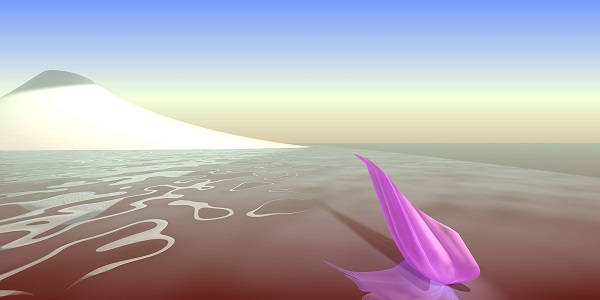
«New Landscape Birth»
digital print | 2016
– Do you agree with the statement that digital computer technologies not only brought art to a qualitatively new level but radically transformed its structure, determined the need to rethink the place of the most fine art in the system of other arts. If so, why?
– If we talk about the possible avantgarde in contemporary art – indisputably, nowadays it is digital art. It has its own independent, unlimited and unique space; it has its constantly developing tools, this space "gave birth" to new ideas and concepts that were not there before the advent of the computer, as in the case of «Computer Viruses», «Virtual Flowers» and other topics. This is the only place where you can be free. The virtual world is the space for the creation of the ideal utopia project, the human dreams hologram.
As for your question regarding the rethinking of the fine art place in the system of other arts ... The basic classification, which was, remains the same. We all live in the material world and are engaged in the formation and improvement of the surrounding environment and the space in which we live, in parallel affecting directly or indirectly by our works the topics, which are interesting for us. Through fine arts, sculpture, architecture, music, cinema, etc. Either through the arts synthesis, which is for me, as for an architect, also as close as possible – the creation of an integral artistic environment. And the computer is interesting to me just in the role of a tool that allows you to model in detail those ideas that traditional means cannot be depicted. And to present them either in reality or illusory, depending on the task.
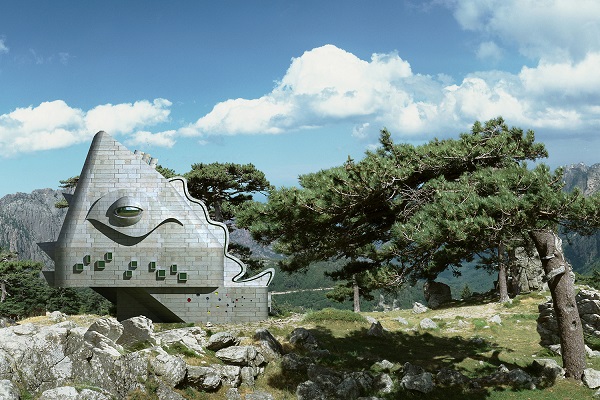
«Architect's House»
architectural project | Crimea, Ukraine | 2006
– Can you find artistic and aesthetic features of different periods of your digital art? Tell us about each of them.
– The main stage is of course architecture, which determined what I do in the visual arts. All I did at the initial stage was dedicated to the search for my visual language in architecture and the formation of space. Therefore, the starting project can be considered «Architect's House» (2006), which was designed during my studies at the academy. A three-story ductile building made of stone, a huge window into the studio in the form of an eye, the reverse side of the façade made of reflecting glass. Life between Utopia and Reality. After I finished it, I realized that I was interested in the image.
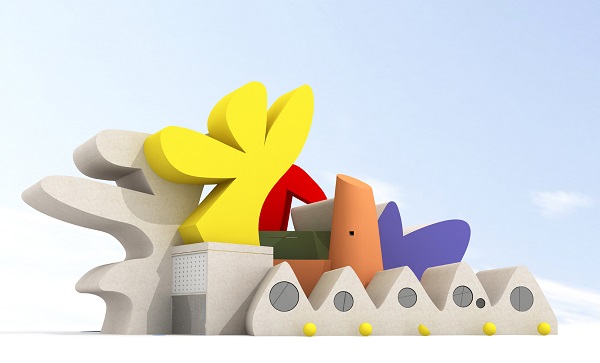
«Country Club»
architectural project |Novaya Dofinovka village, Odesa region, Ukraine | 2007
The next important project for me was the «Country Club» (2007). The role of the village as a source of ethnic culture has always been interesting for me, and in today's state of megacities is more urgent than ever. Expanded cities need to be unloaded, and the concept of the village is transformed into a balanced space of the city-garden. A person feels himself good when he comes into contact with nature and manifests creatively. These concepts, in my opinion, will become the basis of the modern city, each of which should have a space where it will be possible to develop creatively, to reveal its talent and subsequently apply it for the improvement of the environment with an ecological bias.
From a formal point of view, the project was created on the principle of linear forms «extruding». It managed to combine sculpture and picturesqueness with an organized interior space, where it is planned to place creative workshops, a media library, concert and exhibition halls, administrative offices, open areas, etc.
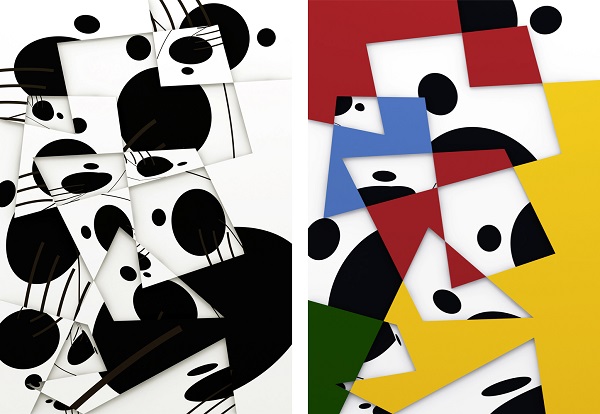
From left to right: «Kaleidoscope III», «Kaleidoscope IV»
digital print | 2007
In parallel in the same year I began to work on «Kaleidoscope» series. At first, the work was meant as a project of large-scale reliefs, which were to become part of the interior space of architectural objects, or, as in the case with «Achilles Cube», – form the shell of the building. Here I began to apply texturing and subsequent manipulation with the image. In 2012, the same idea was transformed into a series of spatial objects, in 2015 - into voluminous reliefs, combined with neon. A bit later, at the invitation of Katya Taylor, I have implemented a large-scale work on the facade of the Comfy main office in the Dnepropetrovsk city center.
«Electronic Winds»
computer animation | 2018
If I remember now, I think that in the «Kaleidoscope» series at that time I was very attracted by the detection of volume on the plane and, as a consequence, the optical effect. This was the impetus for the emergence of «Electronic Winds» project (2008), which was already shown this year in the medium of computer animation at the jubilee exhibition at the Museum of Odesa Modern Art.
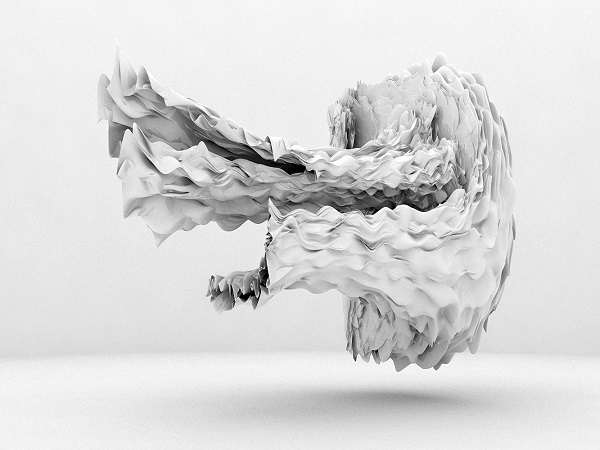
«White Noise». From the «Computer Viruses» series
virtual reality project, computer animation | 2009
«Computer Viruses» I started to create in 2008. It's an idea to visualize something that was originally incorporeal. Each virus has its own creator, name, history, but there is no body. That's what I did [smiling]. For the first time the work of this series was shown in 2008 in the Museum of Odesa Modern Art. It was a computer virus called «Chameleon». In the same period I began to make the first experiments in computer animation and visualized the «digital flesh» in the project «Virtual Meat».
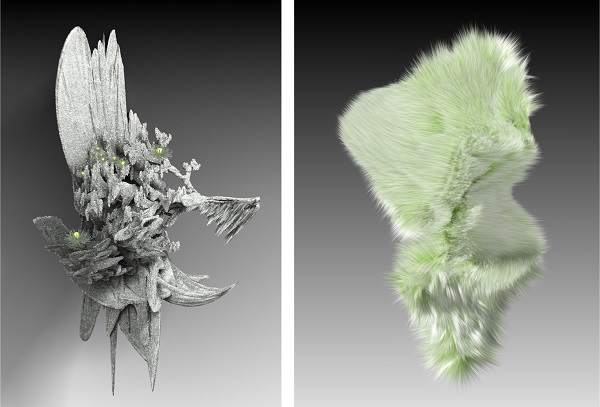
From left to right: «Chernobyl», «Melissa». From the «Computer Viruses» series
digital print | computer animation | 2011
Multifigured plot works appeared in 2009. The first was «Lemon Chickens will be saved…» (2009), which formally grew out of «Country Club» architecture and was created on the principle of a frontal multi-layer theatrical production. This also applies to «The Death of Actaeon» work, a plot inspired by homonymous work, which was created by my father in 1988.
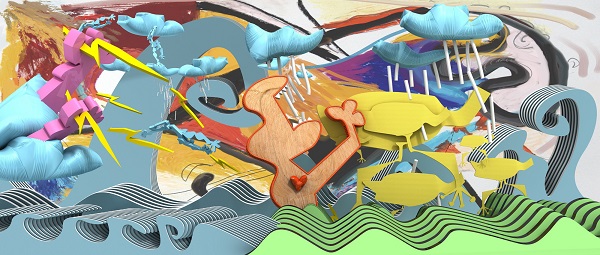
«Lemon Chickens will be saved…»
digital print | 2009
Following them in 2010 there was a work, which received the name «The Temptation of St. Anthony». At this point, I began to work with the formation of the whole space. In this same work, the water surface appeared for the first time, which I continued to use in many of the works in «Virtual Landscapes» series (2011), which then nudged the idea of «growing» flowers that do not exist, and create the «Virtual Garden».
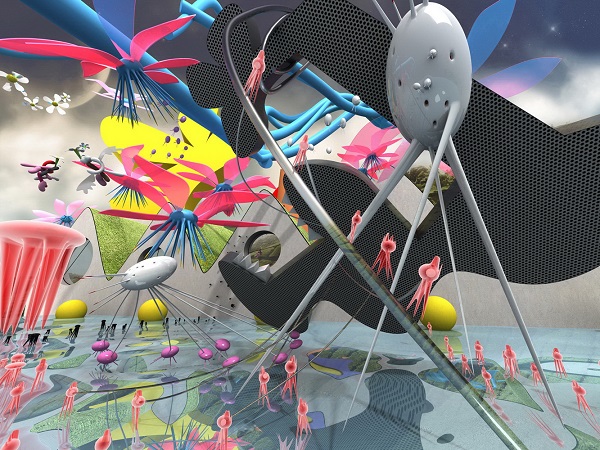
«The Temptation of St. Anthony»
digital print | 2010
«The Shadows» appeared in 2011, shown for the first time in the Victoria Burlaka project «Moments of Silence» at the Modern Art Research Institute, afterwards at the «Independent» exhibition at Art Arsenal. Last year the project was shown in an expanded form at my personal exhibition «Sounds of Silence» at the Odesa Museum of Western and Eastern Art in the framework of international music festival Odesa Classics, organized by Alexey Botvinov.
Shortly, the principle of creating works of this series is to separate the shadow from the virtual object and further work with the shadow image. It reminds me a little of the Peter Pen case [smiling].
«The Chandelier» | video projection, 2015 – 2017
«Sounds of Silence» exhibition | Odesa Museum of Western and Eastern Art, Odesa | 2017
– Tell me more about neon installations. What is unique about this material?
– Material uniqueness for me lies in its luminosity and graphics. This gives me the opportunity to laconically depict and highlight the meaning. And since my first neon installations were focused primarily on the images bordering on the sacral theme, the neon material itself automatically shifted from the street aesthetics of the entertainment establishments to completely opposite ideas. So this is a very organic duo of the theme and technology.

«Gleam» | 203 х 151 сm, digital print on aluminum, neon| 2011 – 2013
«Premonition: Ukrainian Art Now» exhibition | Saatchi Gallery, London | 2014
Photo by Dan Kitwood
The first light installation project was «Gleam» (2011). Initially, it was assumed like one of the works from the «Shadows» series, which I subsequently converted and combined with neon. My idea was to enlighten matter through and to visualize that component of a person that it is impossible to see in a natural way. Light line was needed, neon became it.
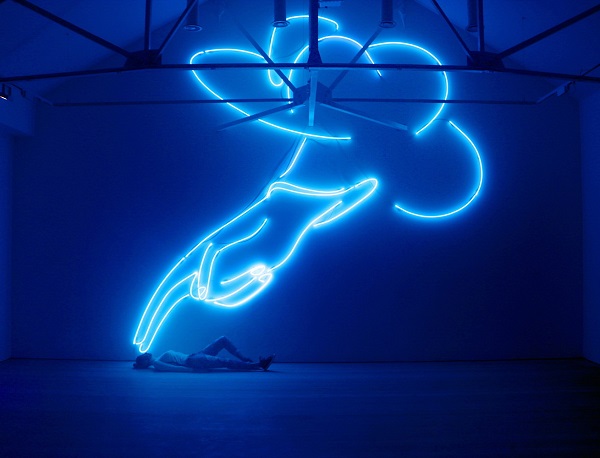
«Blessing Hand» | 500 х 500 сm, neon | 2012 – 2013
«Premonition: Ukrainian Art Now» exhibition | Saatchi Gallery, London | 2014
And the work was shown for the first time after two years at «The Power of IT and Life of Genius» exhibition at the Museum of Spiritual Treasures of Ukraine, which was organized by Dmitriy Struk and Denis Rudenko. This was their first exhibition. I remember that the terms were rather short and there was already a talk about using other works. And I am grateful to Denis, who then at the last moment insisted on the implementation of this particular installation and found a financial opportunity with Dima to do it. Although, I confess, I was very worried, for me it was the first experience of this kind, a complex multi-component design, everything had to be done very technologically. And, thank God, they did it. Its subsequent story is very successful. In 2014, along with «Blessing Hand» work was selected for the «Premonition: Ukrainian Art Now» exhibition at Saatchi Gallery in London, in 2015 it was shown at Cosmoscow in the Gostiny Dvor in Moscow, in the same year at the National Art Museum in Kiev at the «Odesa Conceptualism» exhibition.
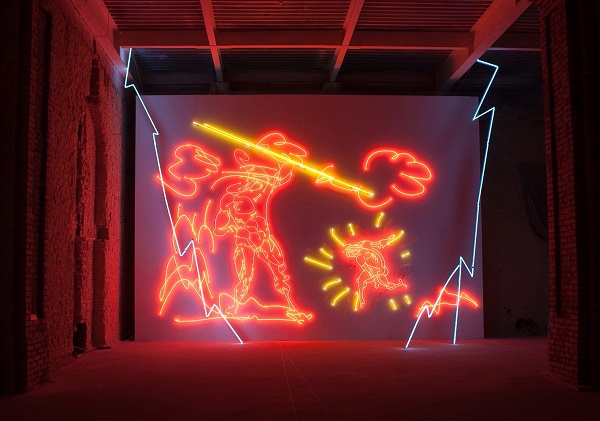
«New Era» | 610 х 860 сm, neon | 2011 – 2012
«Arsenale 2012» exhibition | Art Arsenal, Kiev | 2012
In parallel with «Gleam» work the project of a large-scale «New Era» neon installation was also created, implemented in the first Kiev Biennale «ARSENALE 2012». The exhibition concept was the "Best Times, Worst Times – Revival and Apocalypse in Contemporary Art" theme. And I suggested creating a neon installation. Alexander Soloviev, who was one of the Biennale curators, supported the idea, and, what was very important, found an ideal location to place the work on the second floor, which fitted there organically. At the end, it all looked like a huge light painting in a medieval castle.
«Appearance» | 500 сm, steel | 2012
M.M. Gryshko National Botanical Garden, Kiev | 2012
From Igor Voronov Collection
– Do you consider it like your mission to bring digital art to the real world?
– This is one of the ideas which I’m interested in. At first there were digital images, in parallel I was working on their materialization. The first realized object through computer modeling was a five-meter «Appearance» sculpture (2012), made of steel. In the case with «Walking Cloud» (2013), three-dimensional printing was applied, after which the sculpture was cast in traditional porcelain technology. Since 2008 I continue to deal with computer animation, virtual and augmented reality.
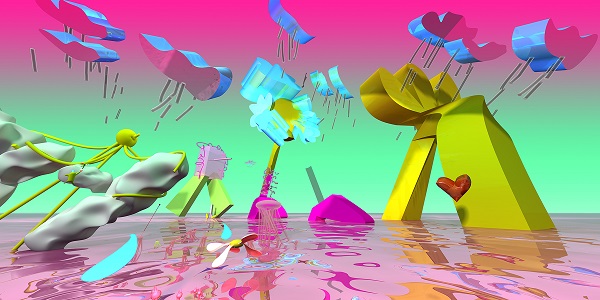
«The Great Walk»
digital print | 2016
– What causes the leaving from static work and the transition to animation?
– Not leaving, but rather an option. Static has its own charm – it's like a stopped frame, everyone can show imagination and present it in their own way a possible turn of events. Animation is an intensification of dialogue, at the sensory level it is almost a tactile sensation.
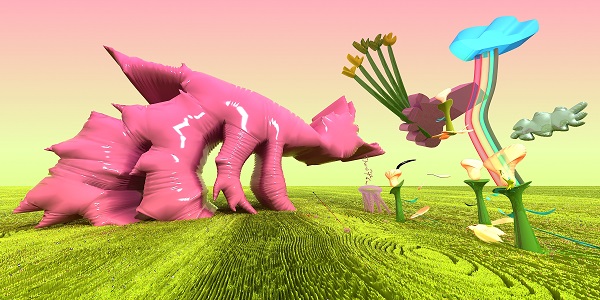
«Pink Fox»
digital print | 2012 – 2018
– Explain the essence of the environment design concept in an image format?
– The essence lies in the methodology of creating works, namely, by analogy with architectural design – in three-dimensional modeling of objects in virtual space, the subsequent fixation of the selected fragment of the projected scene and its further representation in the form of a static image, animation, etc. This, in fact, the visualization of the project. But if in architectural design this is an intermediate stage before the implementation of the object, then in my case – implementation is often not the ultimate goal, because the native place of habitation of my images is digital.
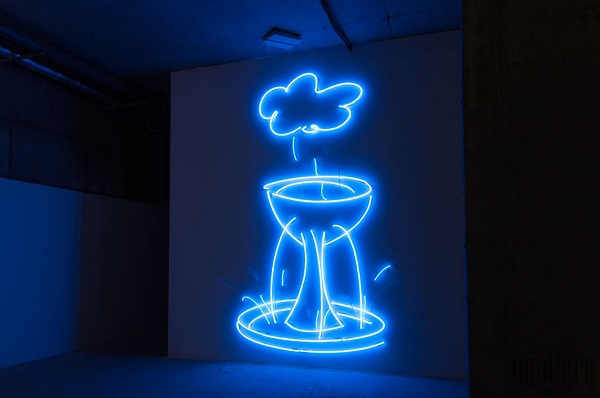
«The Source» | 370 х 240 сm, neon | 2018
«Kyiv Art Week» exhibition | Toronto business center, Kiev | 2018
– How do you feel about the edition art?
– Perfectly. In a single copy, in limited edition or in digital form – the originality is not affected; digital art is about accessibility, mobility and transformation. The essence and quality of work is important, not the quantity. Edition in art was always in the Middle Ages in Europe, and even earlier in Asia. And if the technology allows more people or museums to own the work, or to change its format, scale or quality with the arrival of more advanced technology, it would be strange from my side not to use it.
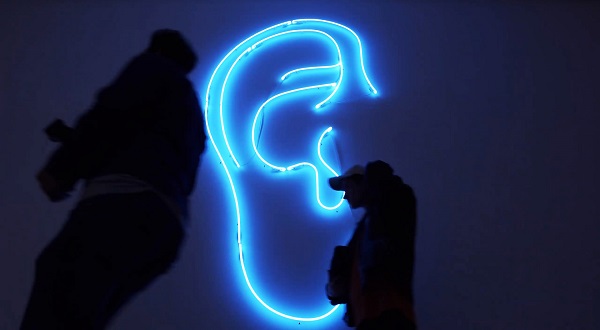
«All Hearing Ear» | 300 cm, neon | 2015 – 2016
«Permanent Revolution» exhibition | Ludwig Museum, Budapest | 2018
– You took part in the international «Permanent Revolution» exhibition in Budapest, where works of several generations of Ukrainian artists are presented in the context of social and political transformations. What are your impressions of the organizers and curators of this initiative?
– Undoubtedly, the idea and the opportunity to show the works of Ukrainian artists in the Ludwig Museum is an important event and it is worth giving due thanks to everyone who took part in his organization. I wasn’t able to be present at the opening, I saw the exposition on photos and video, it turned out very worthy. For my part, the curators selected «All Hearing Ear» neon installation; and, in my opinion, very timely. As I said before: «We all need to learn to listen and hear each other».
But at the same time, I am concerned that recently our art is often shown through the prism of problems, often political ones, which in themselves are very ambiguous, and thereby color the notion of Ukrainian contemporary art as something marginal and critical. And this is far from being true; this is only a small part of it and is far from the most indicative. Therefore, I have big hopes that in the nearest future absolutely different topics will be raised, mostly aimed at the representation of new ideas and positive thinking.
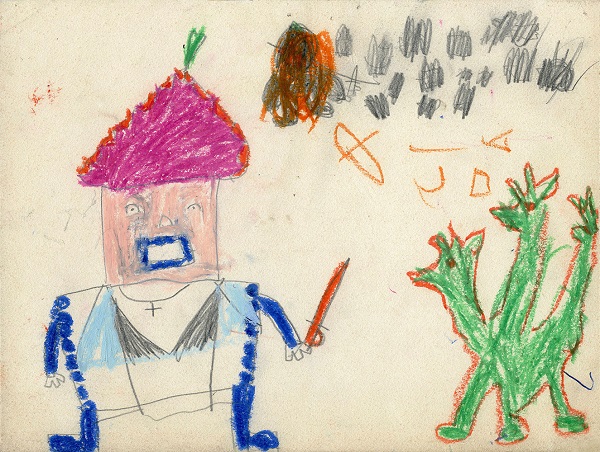
«The Nutcracker» | 20 х 26,5 сm, paper, pencil, pastel | 1990s beginning
Photo from the family archive
Why is your child's drawing taken as the basis for the work, which is nowadays presented at the «Instant Time» exhibition?
The Odesa part of the exhibition was curated by Maxim Kovalchuk, who touched upon a very interesting topic for me, namely, childhood. As far as I can remember, literally, the idea immediately came: to take my baby drawing created just in the early 1990s and to transfer it in time, rethinking the plot, and implementing as a monumental work in the technology with which I work today as an artist. Among the large archive I found a story about the Nutcracker and Rat King, which was made in graphic technique, which allowed to reproduce as accurately as possible all the lines and color of work in neon technology. I called the work «War and Peace».
«War and Peace». From the «Baby Talk» series | 400 х 500 сm, neon | 2018
Video by Maxim Belousov
Can it be said that its main theme is «Memory as a source of cultural research»?
For me as for an author it was very important at the time of creation the sense of rapprochement and association in the time of my childhood and memories with my present condition. Simply put, on the one hand this work makes me very warm childish memories, as well as an awareness of the dual plot of war and peace that haunts us in life in one form or another on the other side. And the third aspect is the boundary between these two components.
Do you see elements of primitivism in this work, naive, because children's creativity is close to them because of freedom from any rules?
Here, for certain it is difficult to talk about the term primitivism, tk. he often refers to already grown-up people who paint naively for reasons that are deliberate, or for reasons of professionalism lack. And in the case of children's drawings – this is a given person, who recently came into being. Therefore, this is just for me the value – childish freedom and sincerity, which is often lost in the process of growing up, to transfer into the field of «adult» art.
About the author:
Roksana Rublevskaya – ART UKRAINE editor-in-chief, journalist and author of articles on artistic subjects.


